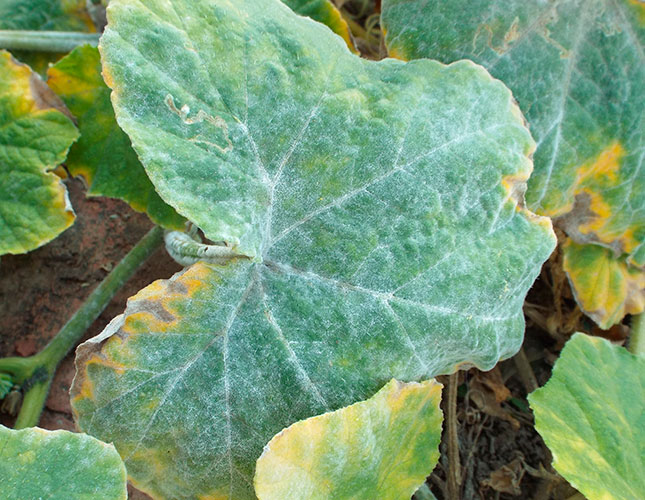
‘Powdery mildew’ is an umbrella term used to describe several types of fungus, the majority of which are host-specific. This means that they attack only one type of plant; the powdery mildew on butternuts will not spread to apples, for example.
However, all forms of powdery mildew favour the same type of condition and look very much alike. Initially, the disease appears as greyish-white blotches on the leaves and stems of the host plant, although it can also be present on fruits and flowers. As it takes hold, it gradually spreads to form a powdery blanket-like coating, hence its common name.
Dispersion and survival
On the plant’s surface, the fungus produces microscopic spores that are dispersed in the air or transported by insects. The spores have a higher water content than those of most other fungi, which enables them to survive and infect plants under much drier conditions than would normally be the case with other fungal infections.
The fungi either overwinter as a dormant infection on living plants, or in a ‘resting’ phase among plant matter. Come spring, the fungus starts asexual production of new spores, which begin to disperse. It thrives in dry, shady areas where there is little air movement, and has a preferred temperature range of 15°C to 26°C.
Damage
The fungus enters the cells on the leaf surface where it taps into the plant’s food store. In small infections, powdery mildew will have little effect on the plant, and although unsightly, is rarely fatal. As it begins to spread, however, and more of the leaf’s surface is covered, it can seriously inhibit the leaf’s ability to photosynthesise. This weakens and reduces plant growth, deforms fruits and buds, and yellows and sheds the leaves.
Prevention and natural control
There are several approaches to controlling powdery mildew. Prevention is a good place to start. Remove and burn – do not compost – infected leaves that have fallen to the ground or are showing signs of infection. This will prevent the fungus from spreading and help reduce the amount of potential infection the following spring.
Some other tips:
- Reduce the amount of dead matter lying around or near the crop. These could harbour powdery mildew spores.
- Keep plants well watered. This reduces water stress and their susceptibility to infection.
- Improve circulation around the plants by thinning or pruning. Prune and destroy infected shoots.
- Plant powdery mildew-resistant strains, particularly in areas prone to the fungus.
Chemical control
Many commercial fungicides that can deal with powdery mildew are available, but be sure to check that your chosen product is safe and effective to use on the type of plant infected. In crops known to be prone to powdery mildew, a systemic fungicide should be used.
Follow the manufacturer’s recommendations regarding fungicide application. Some may require repeated applications to ensure continued protection. Rotate fungicides to avoid powdery mildew building up a resistance to the chemical.
Start treatment as soon as the fungus is spotted to avoid it gaining a foothold on the plant. As the spores can lie dormant on plant matter, once these have been removed and burnt, spray the ground with a fungicide to kill any remaining spores.
Paul Donovan is a Botswana-based zoologist who advises farmers on pest control methods.








